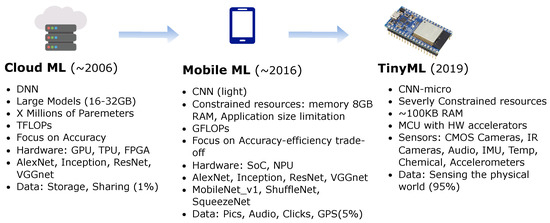1. Introduction
Data production has expanded at an extraordinary rate during the past decades [
1], owing to the widespread deployment of sensor technology and the increasing digitization of the world. This tendency has been assisted by the increased processing and data storage capabilities offered by cloud technology. The growth in computational capabilities has expedited the study and development of deep neural networks (CNNs) [
2,
3], which have grown in complexity and resource demands through time. Cloud computing currently handles the most complex AI models with millions of attributes that require terabytes of memory and lightning-fast computation. Because they have infinite computing resources and memory, these massive neural network models are primarily concerned with accuracy and speed.
Mobile computing arose with the arrival of mobile devices such as tablets, smartphones and laptops. Mobile computing [
4] is mostly concerned with wireless communications for mobile devices, which have profited from technological advancements such as low-power CPUs, tiny memory, and low-power display technologies. Shortly afterwards, mobile computing systems began to be applied in a variety of fields such as robots, autonomous vehicles, and augmented reality, which demand the performance of real-time tasks in a very short period without relying on cloud-based computing. This transition to mobile platforms has sparked the creation of a new type of neural networks [
5,
6] that are smaller in size and prioritize model efficiency above accuracy. depicts the advancement of such technologies (Cloud ML, Mobile ML and TinyML) over time from 2006 to 2019.
Figure 1. The advancement of computing technology over time.


No comments yet